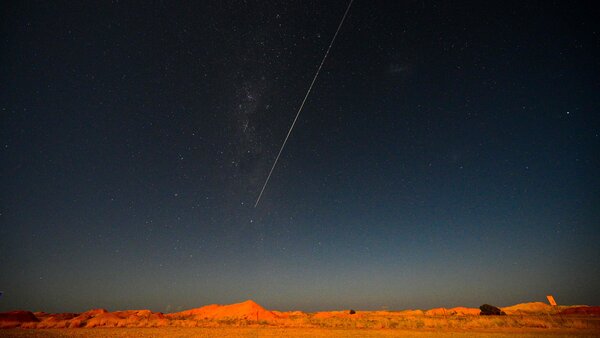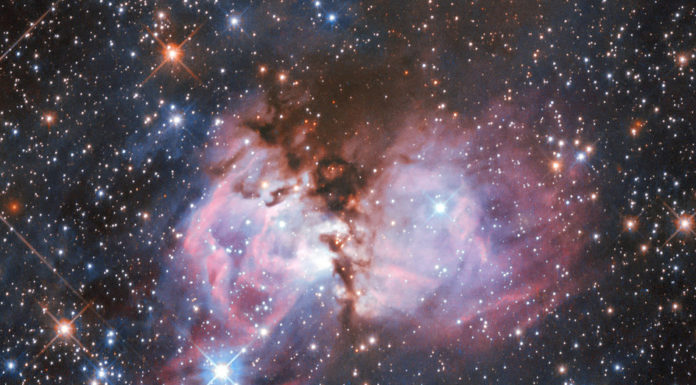A blazing reentry fireball brings to a close a six-year mission to asteroid Ryugu.
It surprised, dazzled, then disappeared in a flash. In the early hours of Sunday morning, local time, the sample capsule of Japan’s Hayabusa2 spacecraft plowed through the atmosphere over the Australian mining town of Coober Pedy, blazing an ephemeral trail of fire through the sky.
Above the Lookout Cave Motel in the center of town, just before 4 a.m. local time (9:30 p.m. PT), about a dozen people gathered and mingled. Tripods were erected and camera equipment was fine-tuned and pointed at the sky. Then, without a sound, a twinkling point of light appeared out of the dark. It moved quickly. The crowd erupted with “oohs” and some pointed their phones at the sky.
Among those wowed by the show were 34-year-old Ross, from Townsville, and his two sons, 6-year-old Max and 8-year-old Chase. “It was pretty cool,” Ross said. “It was worth getting up early for.”
Locked within the capsule is the first ever subsurface sample from an asteroid. The Japan Aerospace Exploration Agency (JAXA) confirmed that the 16-inch container had touched down on the flat, ochre plains of the Woomera Prohibited Area more than 200 miles southeast of Coober Pedy at approximately 4:37 a.m. local time (10:07 a.m. PT, Saturday).
The landing is the culmination of a decade of work by JAXA scientists and engineers, and it comes six years after Hayabusa2, which is about the size of a washing machine, departed Earth. The spacecraft travelled over 3.2 billion miles on its journey to near-Earth asteroid Ryugu and back, spending over a year using specialized cameras, radar and an infrared imager to survey the spinning top-shaped rock. On two occasions in 2019, it collected samples from the surface in brief snatch-and-go maneuvers.
Masaki Fujimoto, deputy director of JAXA’s Institute for Space and Astronautical Science (ISAS), says the mission has been one of the defining moments of his life, As it came to a close, it was obvious the stunning finale and recovery operations would be bittersweet.
“This is the last time we will all be together,” Fujimoto said.
There’s still some work to do yet, starting with ensuring the contents of the capsule are safe. The recovery mission took place in the predawn dark of the outback and confirmation of the capsule’s collection is still pending.
Outback adventure
The Australian Space Agency and the Department of Defense (DOD) played a significant role in the capsule’s safe return. The DOD manages the Woomera Prohibited Area (WPA), a huge swathe of land, about half the size of the United Kingdom, where the capsule was guided after release from Hayabusa2 on Saturday. Road closures kept residents from passing through the region for almost 12 hours, as a precautionary measure.
JAXA engineers tightened the final landing zone to an area about one-tenth that size, with some deft maneuvering while the spacecraft was traveling back to Earth.
The sample entered the Earth’s atmosphere moving at about 7.5 miles per second, but as it hit the dense atmosphere it slowed down to around 110 yards per second, throwing off its heat shield and deploying its parachute. After gliding for about 20 minutes, it landed on the red, Mars-like plains of the WPA.
Michelle Xu Ke, who watched from Williams Creek Road sent me this: look at this dazzling tail from #Hayabusa2 !!! This is so cool, and just from a camera phone. pic.twitter.com/L6ghHdGw2h
— jack ryan 🙏 (@dctrjack) December 5, 2020
To help locate the sample capsule, members of the Defence Force locked on to it as it first began burning through the atmosphere, tracking it with ground cameras and radar. This enabled the JAXA team to locate the sample and send its helicopter team to fly out and collect it at approximately 4:47 a.m., local. The very first person who had the honor of touching the capsule was a safety officer, says Satoru Nakazawa, who led the recovery mission.
Once it acquired the capsule, the recovery team quickly ferried it to a pop-up laboratory within the Woomera Range Operations Center, known as the Quick Look Facility or QLF.
What’s in the box?
The team predicts that Hayabusa2 collected about one gram of material from Ryugu, based on observations from the spacecraft’s cameras. Confirmation of exactly what was nabbed during Hayabusa2’s two heists is expected over the coming weeks.
JAXA’s specialist retrieval team located the capsule at approximately 5:34 a.m. local time and took it back to the QLF for testing. According to JAXA’s Hayabusa2 Twitter account, all operations ended at 6:01 a.m. local (11:31 a.m. PT). “The operation was perfect,” the tweet read.
Hajime Yano, a scientist with ISAS, says the sample capsule won’t be opened until it’s returned to the ISAS facility in Japan. However, a device that can measure small amounts of gas in a sample was erected within the QLF to make the first analysis of the capsule.
The facility includes a clean room, and staff must be dressed head-to-toe in protective gear — not because of concern over some long-dormant alien asteroid disease or even COVID-19, but to protect the sample from any contamination. After the return, Yano and his team punctured the bottom of the capsule to detect any residual gas. A preliminary analysis will enable researchers to tell whether Hayabusa2 was successful in snatching pieces of rock and debris from the surface of Ryugu.
Fujimoto says the capsule will be pried open in Japan sometime “around December 20th.” The contents of the capsule are expected to improve our understanding of the early solar system and the Earth.
Previous observations of Ryugu by Hayabusa2 have suggested there are traces of water-bearing minerals within the asteroid. Some scientists believe this may have been how water was brought to Earth’s surface and potentially, how organic material rained down on the early planet and kick-started life.
Return to Woomera
Many JAXA team members will now turn their attention to Phobos and Deimos, two moons of Mars. The Martian Moons Exploration (MMX) mission is scheduled to launch in 2024 and would likely return a sample obtained from Phobos’ surface by 2029.
The mission will feature partnerships with NASA, the French Space Agency and the European Space Agency (ESA). It’s also likely to feature another key partner: Australia. Though not officially confirmed, Fujimoto has hinted those samples would also touch down in the outback.
“With my experience this time, I’m really inclined towards having Woomera as a landing spot,” he said. “We want to continue to collaborate.”
Fujimoto says the interests of JAXA and the interests of the Australian Space Agency are closely aligned. Megan Clark, head of the Australian Space Agency, is enthusiastic about keeping the relationship between Japan and Australia going, allowing the nation’s fledgling agency to continue to grow.
“International partnerships are pivotal for us,” she said. “We cannot transform our own space industry and grow the jobs here without the depth of international partnerships.”
Hayabusa2’s sample return mission is over, but the spacecraft hasn’t been retired. JAXA engineers and scientists will steer the probe to another two asteroids over the next decade. And there may be another Hayabusa mission in the works, too. JAXA personnel have dropped tantalizing hints that the duology could become a trilogy in the future. Will we see a Hayabusa3? That’s a distinct possibility.













![Hotstar Premium Cookies 2019 [*100% Working & Daily Updated*] Hotstar Premium Cookies 2019 [*100% Working & Daily Updated*]](https://tahav.com/wp-content/uploads/2019/11/Hotstar-Premium-Cookies-Free-100x70.jpg)



